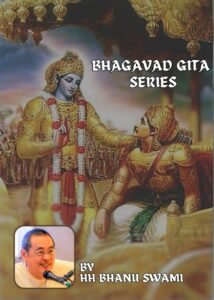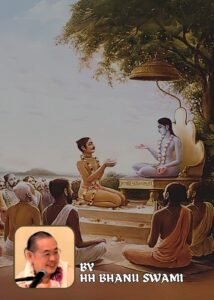Vraja Riti Cintamani | Part 5 | Verse 3.1~3.60 | HH Bhanu Swami Maharaj | Shravana Utsav 2024
nama om vishnu-padaya Krishna-preshthaya bhu-tale
srimate bhaktivedanta-svamin iti namine
namas te sarasvate deve gaura-vani-pracharine
nirvishesha-shunyavadi-pashchatya-desha-tarine
Sri-Krishna-caitanya
prabhu nityananda
sri-advaita gadadhara
shrivasadi-gaura-bhakta-vrinda
Hare Krishna Hare Krishna Krishna Krishna Hare Hare,
Hare Rama Hare Rama Rama Rama Hare Hare
So yesterday we talked about certain places, specific places like Vamsi Vat, Govinda Kunda, Nidhuvan etc., Dheera Samira. So now a very special place is described, that is Govardhan. We know that Govardhan was very important to the people of Vrindavan because Nanda Maharaj used to do special worship to Indra.

And he did the worship to Indra because Indra gives rain, rain gives grass, grass is good for the cows. But then Krishna argued, don’t worship Indra, worship Govardhan because Govardhan is giving the grass. And then Nanda Maharaj agreed, yes, Govardhan, we take all the cows to Govardhan and they eat all the grass, they become healthy, so let’s worship Govardhan.
So Govardhan is described as the king of mountains. So it’s called a mountain, but if we look at Govardhan the hill, today it’s like a hill only [Laughs]. But we hear the descriptions in these verses, it looks very tall and it’s got waterfalls and caves and so many features. And we’ll find in the Bhagavatam and other literatures, Govardhan is praised as the best servant of Krishna. So it is one of the major assistants in Krishna’s pastimes. So Govardhan is a servant and the servant has various services, he does.

So Govardhan acts as Krishna’s throne where he sits. It can also be his bed [Laughs]. And if he’s eating he can sit down there and eat. So in this way, Govardhan has many types of services. So even the stones and the rocks and whatever serve Krishna very nicely. And they all serve for the pastimes of Krishna. And the pastimes are presented or enacted in order to increase rasa. So therefore, Govardhan is celebrated for increasing rasa.

So as I described Govardhan has many caves. And also has many bowers. Yesterday there was a description of the bowers and the pavilions made out of various gems. So many of these bowers are on Govardhan. Of course today we won’t see those things if we look at it with our material eyes. But Krishna has many pastimes on Govardhan hill in these bowers with the Gopis. So because it’s an assistant to the pastimes in Madhurya Rasa with the Gopis then this hill is celebrated even more.
So of course in the Upadesamrta, Mathura is glorified and within Mathura then Vrindavan is glorified and in Vrindavan then Govardhan is glorified. So Vrindavan and Govardhan of course they serve all the rasas. But Govardhan particularly is useful for Madhurya Rasa.

So on Govardhan there are many trees and creepers. So they supply flowers and fruit. They supply pollen which is used for decorating. The trees supply honey and buds which they use for decorating. The mountain also has various minerals. So these are colors used for different dyes. And we see in Bhagavatam it is described that Krishna decorates his bodies with different colored clay. So we get red color, white color, black color, yellow color etc.
And when Krishna decorates himself along with the cowherd boys with these different colors this becomes very attractive to the gopis.

So the other day it was described that there are musk deer [Laughs]. So musk is often mentioned in the scriptures because it is very fragrant. And the musk comes from these deer, special deer. So of course in the modern world you have to catch the deer and somehow you squeeze out this musk but in Vrindavan the deer just leave the musk [Laughs]. They don’t have to catch the deer.

And then of course we have to manufacture camphor and kumkum but here it is sitting on Govardhana naturally. And there is also Krishna aguru, which is also a very famous scent. So as well as minerals to decorate there is also many scents or perfumes that Krishna can use.
Of course in the modern world generally maybe women use perfumes, men don’t really use perfumes much [Laughs]. But if you read Bhagavatam and other literatures you will see that Krishna is always decorating himself with these different scents. And this also helps to increase the attraction of the gopis.
Of course in the rasa itself one of the ingredients of rasa is called uddipana. That means a stimulus for rasa. For instance if the gopis see Krishna’s peacock feather they get stimulated, excited. If they hear his flute then they get excited. If they see a garland of Krishna in the forest they get excited. Similarly if they just smell the fragrance of Krishna, the musk or the sandalwood or the kumkum or the camphor from Krishna they get excited.
When the gopis were looking for Krishna in the forest after he disappeared in the rasa lila then they were looking around and they thought maybe we can smell the scent of Krishna. He must be around here somewhere because we can smell these perfumes. So these different perfumes of Krishna will act as a stimulant or a uddipana for their rasa.

So on Govardhan there are sandalwood trees. Now sandalwood trees are famous because at the base of the sandalwood tree there is snakes [Laughs]. But in Govardhan there are no snakes. So therefore, the sandalwood trees in Vrindavan are quite unique. But Srila Vishvanatha Chakravarthi Thakura said that even if there are snakes there for some sort of rasa they don’t have any poison. If they have poison, the poison has no pain to it rather it gives joy to Krishna [Laughs]. So in other words there is no danger from snakes in Vrindavan.
So then he tells here one event on Govardhan, one Gopi decided she didn’t like Krishna so she left him. But then she saw a snake and then she got frightened and then she came back and embraced Krishna [Laughs]. So in this way the snake is used as a prop or an ingredient for increasing rasa. So similarly with other creatures that may look fearful to us like tigers and lions or whatever, they may be there, but they give up their fearful natures. But they may be useful also for stimulating the gopis to approach Krishna.
And thus we see descriptions of Radha. The bees are around and she is afraid that they are going to sting her [Laughs]. So she takes shelter of Krishna. But ultimately the bees in Vrindavan don’t sting.
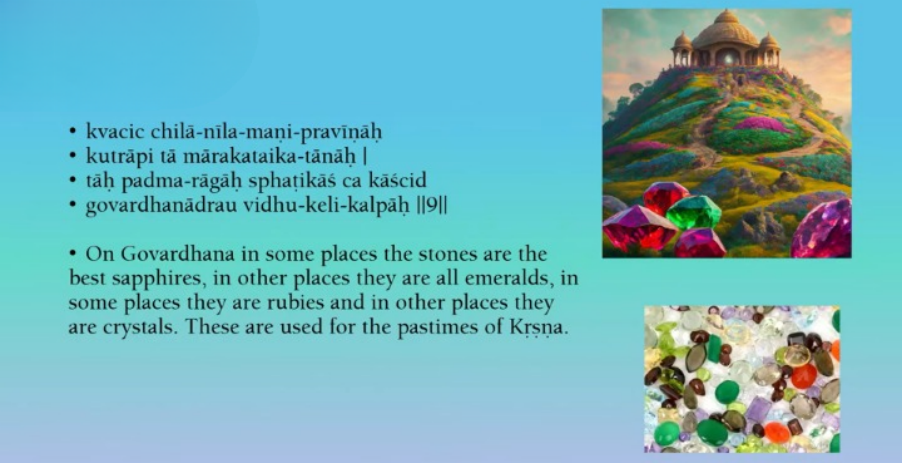
Okay on Govardhan then there are many jewels. There are sapphires. Sapphires are blue. In other places the stones are all emeralds. That’s green. In some places the stones are all rubies. In other places all the stones are crystal. So all these different jewels are also useful in the pastimes of Krishna. Of course the cow herds and Krishna and the gopis could make ornaments out of jewels. But we often see that they use flowers and buds and leaves. But still the jewels are also useful for them.
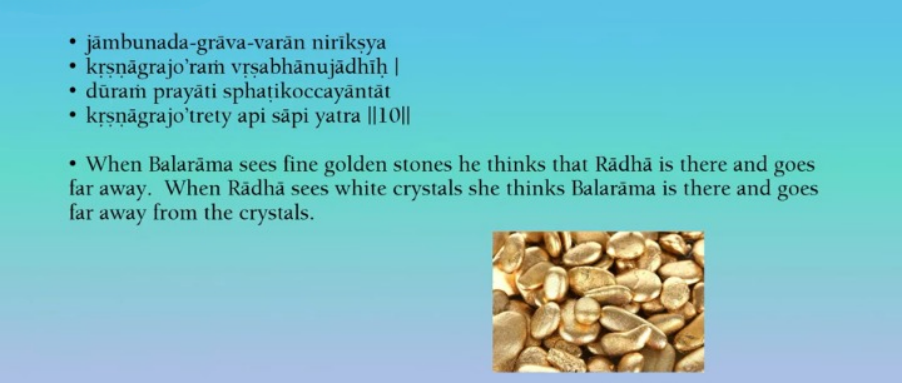
So some places have got are all golden stones. And then Balarama sees that. Then he thinks that Radha is here. So there he leaves, he doesn’t associate with Radha. Some places it’s all crystal which is white. And Radharani sees that. Then she says Balarama is here. So she leaves. So in this way the different jewels in Govardhan act as a stimulus for certain types of rasa.
And when Krishna sees gold nuggets on Govardhan, then he thinks Radha is here. So he approaches Govardhan hill. So Govardhan in some places is covered with sapphires. And when Radha sees the sapphires then she says Krishna is here. So she comes. So in this way again the jewels act as a stimulus for their rasa.

So Vishvanath Chakravarti Thakur gives a little image here. So Govardhan is like a necklace. And on the necklace Krishna is the sapphire and the gopis are the gold chain. So though Govardhan is covered with all sorts of jewels the real jewel is Krishna, the sapphire. And the gopis are a gold chain. And they become the best decoration on Govardhan in spite of all the other jewels there.

Okay so he also says in this particular verse that all the pastimes on Govardhan between Radha, Krishna and the gopis the pastimes are like children. So these children never separate from the parent, that is Govardhan. So in this way Govardhan is always useful for the pastimes of Krishna and the gopis.
Of course we shouldn’t think that Govardhan is only useful for Madhurya rasa. We see that the cowherd boys also come with Krishna to Govardhan hill and they herd the cows there and play games etc. And we also see that the elder cowherds also come to Govardhan.
So in the Brahma Vimohana Lila it is described that Krishna was all the calves and all the cowherd boys for one year. So after one year of course all the cowherds were attracted to their children because they were actually Krishna. And all the cows were attracted to the calves which were Krishna.
So Bhagavatam describes after one year the cowherds had come to Govardhan hill and they were grazing all the cows, grass on top of Govardhan hill. And the cowherd boys, Krishna’s friends were at the bottom of Govardhan with all the calves. And when the cows saw the calves who were actually Krishna they forgot about the cowherds and they ran down the mountain to meet, lick their calves who were actually Krishna [Laughs]. And the cowherds are very angry at the cows because they disobeyed them. But the cows forgot to eat grass because they saw Krishna [Laughs]. But when the cowherds got to the base of the mountain and then they saw their sons who were also Krishna then they forgot their anger. And they embraced their sons. So this pastime takes place at Govardhan also so the cowherds were grazing their cows on Govardhan and the cowherd boys were playing on Govardhan also.

So thus we see in Upadesamrta that Govardhan gets praised as superior even to the forest of Vrindavana. One of course because Krishna raised up the hill with His hand and then Govardhan acted as a shelter, an umbrella to save all the people from the floods of Indra. This helped Krishna fulfill His vow to always protect the people of Vrindavana. But Govardhan is also superior to the rest of Vrindavan because many pastimes took place and especially the pastimes with the Gopis.

To the east of Govardhan is a pond called Dhana-nivartana. This is the place where Krishna would try to get tax from the Gopis [Laughs]. So this is a very famous pastime, which is described in different works by different Acharyas.
Okay and east of that pond is a place where the rasa dance was performed many times. Bhagavatam describes the first rasa lila. That took place when Krishna was 8 years old. But every night after that until Krishna left Vrindavan at the age of 12 there was rasa lila. So they performed this dance in many many different places. So many places are famous for the rasa dance.
Okay so the place near Govardhan where the rasa dance took place is called Chandra Sarovara. And at that place Radha and Krishna become absorbed in dancing. To the west of Govardhan is Dhan Ghat. At that place Krishna had many eating pastimes [Laughs]. And of course at that place also Radha and Krishna had many verbal exchanges. In this place also Krishna tried to get tax from the Gopis. So therefore this place also very very attractive to the Krishna and the Gopis.
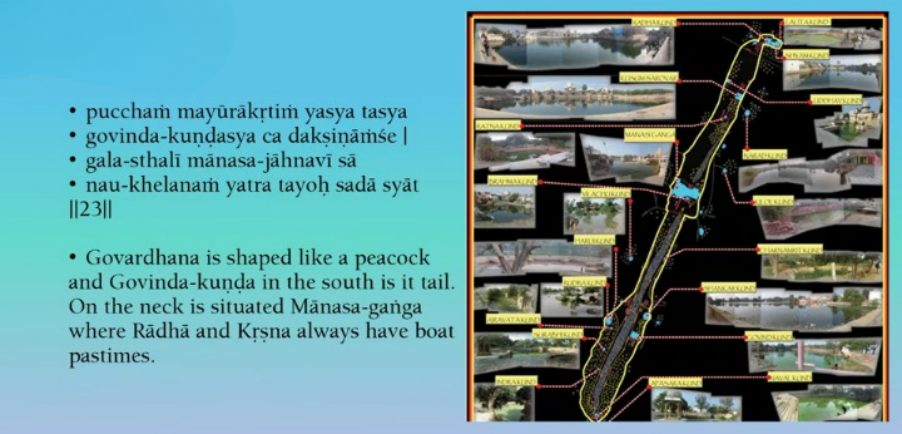
So Govardhan is said to be shaped like a peacock. It is a very long mountain like a peacock with its tail and a head. And Manasa Ganga is situated on the neck. So Radha and Krishna would go to Manasa Ganga and there they would have boat pastimes. So Manasa Ganga like Govardhan is also glorified in the scriptures. So at these pastimes Krishna gets on the boat with the Gopis. But then Krishna makes the boat rock back and forth and the Gopis panic [Laughs]. And they all take shelter of Krishna.
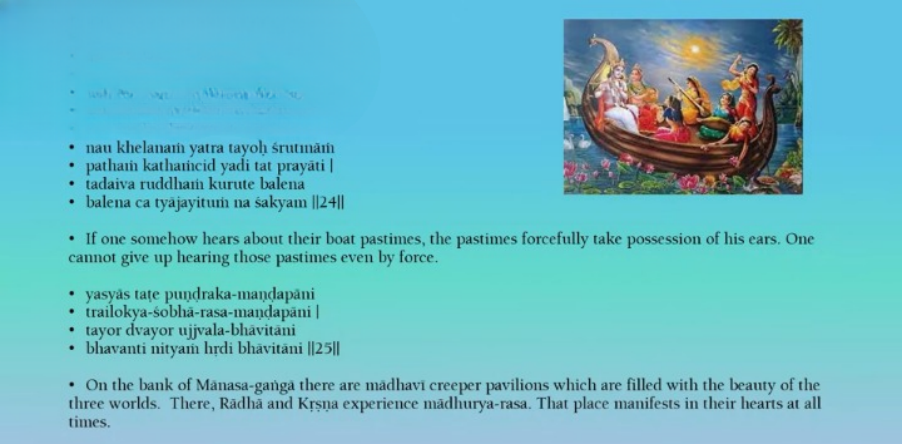
So of course there are also different pastimes describing this. On the bank of Manasa Ganga there is a Madhavi creeper pavilions, different palaces there. So in these places Krishna has pastimes with Radha and the Gopis. So again Manasa Ganga is a place of Madhurya Rasa.
And we have Radha Kunda a and Shyama Kunda a which are like the eyes of Govardhan, at the very tip of the head. So they are said to be filled with Prema. So Govardhan of course is right next to these two Kunda as. So therefore Radha Kunda a and Shyama Kunda a and Govardhan are glorified together.

So of course we also know in the Upadesamrita, Rupa Gosvami also glorifies Radha Kunda a especially as being the highest place in the Universe [Laughs].

So Vrindavan is wonderful, Govardhan more wonderful and Radha Kunda a is the highest place of all. And why? Because it is over flooding with Prema. So Rupa Gosvami says what intelligent person would be unwilling to serve Radha Kunda? So in this way Radha Kunda gets the greatest glorification of all.
Okay, Vishvanatha Chakravarti Thakura says that Radha Kunda and Shyama Kunda are actually the root of Madhurya Rasa. They are the root of beauty. Of course as Kunda they give water. But this is not normal water. They actually produce Prema. So Vishvanatha Chakravarti compares the Kunda as to mines. And what do we take out of mines? We dig jewels out of mines. But out of Radha Kunda we get the jewels of Prema.

And the two Kundas they produce the creeper of pastimes. The two Kunda are said to be the very svarupa or very form of sweetness and Rasa. So in other words Radha Kunda and Shyama Kunda are the essence of Radha and Krishna’s Prema.
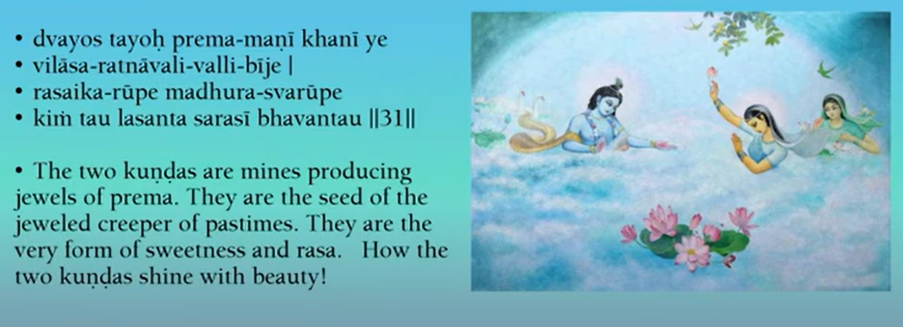
We see in Caitanya Caritamrta that when Caitanya Mahaprabhu went to Vrindavan, then he began searching for Radha Kunda. When Lord Caitanya went there, there actually were not many temples there as we don’t see today it was mostly forest. And there were some farmers there. They had their fields. And place was wild, there were deer there and other animals [Laughs]. But Lord Caitanya saw the spiritual place there [Laughs]. So he was in ecstasy all the time. Of course he is the ecstasy of Radha.
But then at a certain point he thought, where is Radha Kunda? And he began searching for Radha Kunda [Laughs]. And eventually he found a place in a field and that place has since been excavated and developed so it is now very famous. But he particularly remembered Radha Kunda, this famous place very dear to Krishna. So he wanted to find that place.

So when Krishna looks at Radha Kunda then he can see Radha there. And if Radha looks at Shyama Kunda she can see Krishna there. So the wise say that if you look at Radha Kunda and Shyama Kunda you can realize Radha and Krishna.
So often Radha and Krishna suffer from separation. And it is difficult for them to meet because Radha has parents. She also has a husband. So there are all sorts of obstacles. So when they cannot meet they take shelter of the Kundas. So when Krishna goes to Radha Kunda then he feels fully satisfied [Laughs]. So in other words he gets relieved of his separation by coming to Radha Kunda. And similarly Radha in separation from Krishna goes to Shyama Kunda then she no longer feels separation.
So therefore Srila Vishvanatha Chakravarti Thakura says I think that Radha on seeing Krishna she became liquid and she turned into Radha Kunda. So in other words Radha’s prema turned into Radha Kunda. Krishna on seeing Radha turned into liquid and became Shyama Kunda.
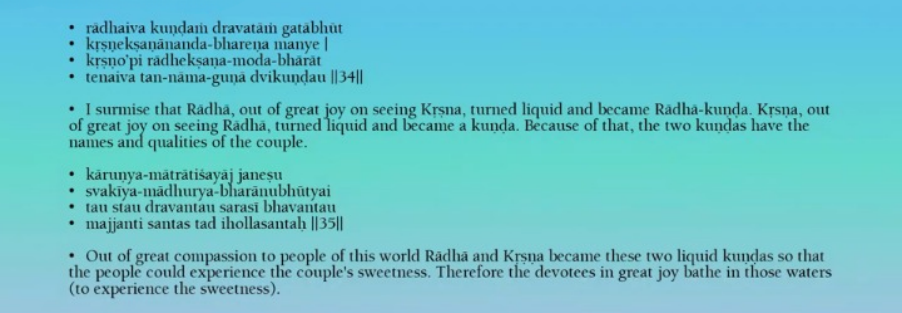
And therefore Shyama Kunda is full of Krishna’s prema for Radha. So in this way the two Kundas are non-different from Radha and Krishna and their prema for each other. So out of great compassion to the people of the material world Radha and Krishna became these two Kundas. And by coming to these Kundas they can experience Radha and Krishna and their love. So thus the devotees will bathe in Radha Kunda and Shyama Kunda so they can experience the sweetness of Radha’s and Krishna’s prema. So by bathing in Radha Kunda one is bathing in Radha’s prema for Krishna [Laughs].
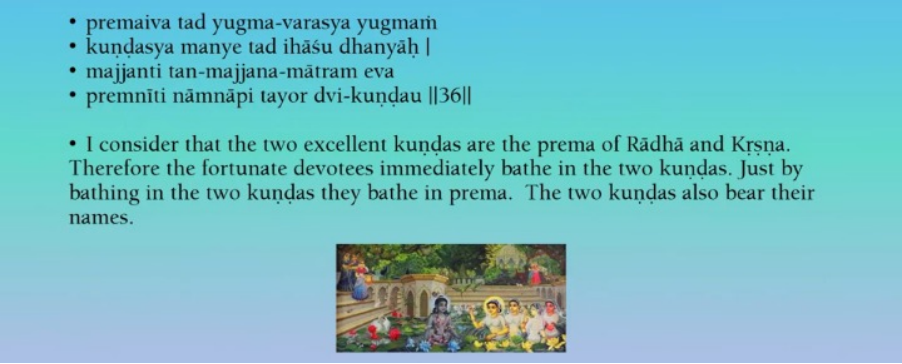
Okay, So these two Kundas are the prema of Radha and Krishna. So therefore the devotees should immediately bathe in these two Kundas. And if they bathe in the Kundas they get prema. So for this reason the two Kundas have become very very famous. We see that after Lord Caitanya they kind of built up the area around the Kundas so when Jahnava came there Nithyananda’s wife after Nithyananda’s disappearance she actually walked to Vrindavan. And she came to Radha Kunda and she also bathed there. So even at that time just after Lord Caitanya’s time Radha and Shyama Kunda were very famous.

Okay, so to the north of the Kunda is a place called Lalitha pramodha this is Lalitha’s bower. Shaped like a lotus and a very nice house made out of jewels. And to the north east is Vishaka’s Bower made of flowers.

To the east of Radha Kunda is Chitra’s colorful Bower. The word Chitra of course means colorful. So she decorates her Bower with different colored leaves and flowers. To the south east is the bower of Indulekha. Indu of course means the moon. So this Bower is like moonlight very white in color.

To the south of Radha Kunda is Champakalata’s bower. Of course Champaka refers to the Champaka flower which is yellow [Laughs]. So if Radha is there with Krishna when Jatila comes she cannot see Radha because it is all gold [Laughs]. So Jatila is always suspicious of Radha. But when she comes there looking for Radha, she can’t find her [Laughs]. She can only see Krishna.
To the south west is a bower called Nila-kunja made of sapphires. So this bower belongs to Rangadevi. So when Radha and Krishna are there no one can see Krishna [Laughs]. So Jatila comes there looking for Krishna to try to scold him. She can’t see him [Laughs]. But Krishna is sitting there with Radha [Laughs]. So good place for them to hide again.

To the west is a pink Bower of Tungavidya. And to the north west is a bower of Sudevi made of emeralds.
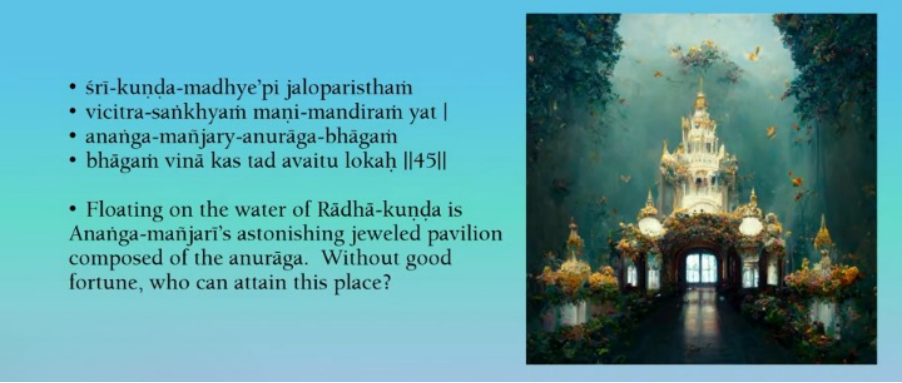
Then there is another bower on the water of Radha Kunda. This is the bower of Ananga Manjari. And this is of course made out of jewels and made out of Anuraga which is a type of Prema. So we know that of course Ananga Manjari is the favourite Manjari of Radha. So in this way we see Radha Kunda is surrounded on all directions, the 8 directions by different bowers for the 8 Sakis in also different colors.

At the beginning of this book Srila Vishvanatha Chakravarti mentioned he is following after Rupa Gosvami and Krishna Das Kaviraj particularly. So Krishna Das Kaviraj wrote one work called Govinda Lilamrita. So this is concerning the pastimes of Radha and Krishna throughout the day. But there he also describes Radha Kunda with all the bowers of the 8 Sakhis around. So quite similar we find the Gopis in the same directions with the same colors in general.

And then Srila Vishvanatha Chakravarti in Bhavanamrta (Krishna Bhavanamrta) another of his works all about pastimes, similar to Govinda Lilamrita, Vishvanatha Chakravarti Thakura also describes all the bowers around Radha Kunda. And generally same directions with the same Sakhis [Laughs]. He also mentions they are ruled by different Devatas. These are the Devatas which are known to rule the different directions.
For instance Yama rules the South, Shiva rules North East. So in this way Vishvanath Chakravarti Thakura is actually following after Krishna das Kaviraj. So this way around the Kunda we have these various bowers. Of course if you go there today you won’t see anything there you will see the Kunda and nothing else [Laughs]. So you have to get the spiritual eyes and then you will be able to see all of this.
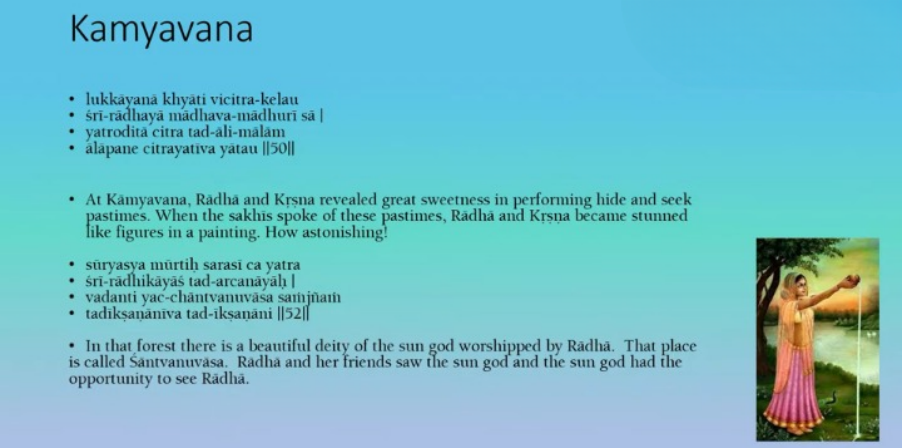
Okay, so after this Vishvanatha Chakravarti Thakura describes Kamyavana. It is actually one of the twelve forests. Kamya of course means fulfilling your desires. So at this place Radha and Krishna would play games of hide and seek [Laughs]. And the Sakhis would speak about such past times and then Radha and Krishna would freeze they would become like pictures, painted pictures [Laughs]. So in Kamyavana there is a temple of Suryadev, Sun God. And Radharani would often go to that temple to worship Suryadev. This of course was just a pretext to get out of the house and go to meet Krishna [Laughs]. She would tell Jatila I am going out to do Surya Pooja worship, so then Jatila would be satisfied. But then Krishna impersonated the Sun God [Laughs] in the temple. So this way Radha and Krishna would meet.
So there are twelve forests and they all are full of wonderful places, wonderful Kundas etc. And these are the places where Radha Krishna and the Gopis would have their pastimes. And they are so attractive even Lakshmi begins to cry in joy [Laughs]. We see in Caitanya Caritamrita there Lord Caitanya describes how even Lakshmi desires to join the Rasa lila. So though she is the consort of Narayana or Vishnu at the same time when she sees Vrindavan and the pastimes there then she finds that Krishna is even more attractive.

So there are twelve major forests but there are many Upavanas twenty four secondary smaller forests also. And of course there are many pastimes that take place there also. Srila Vishvanatha Chakravarti Thakura describes one forest called the Kokila-Kanana which means the grove of the cuckoo [Laughs]. So there Krishna would imitate the cuckoo’s sound and send messages to the Gopis [Laughs]. So in this way Vishvanatha Chakravarti ends this book simply by summarizing everything. So the pastimes, the forms and the places of Radha and Krishna are sources of incomparable bliss.

So they perform their pastimes within this Vrindavan area. So this becomes the most glorious place for pastimes their forms and their places like Kundas etc. It is in the spiritual world but by its mercy it also appears within the material world. But in order to see it in the material world we are going to have to have spiritual eyes. To get those eyes we have to perform Bhakti. And to help us, then if we have some understanding of what the spiritual place looks like then we can also get some advancement in our vision by that.
So by writing such works as this work then and if we study these works then we can get some idea of what the place really looks like when we see Vrindavan. And this helps us advance in our devotional service. That’s it.
Hare Krishna.
Q & A
1) If a transcendental personality like Srila Prabhupada or any Acharyas when they perform their extraordinary qualities, it looks extraordinary for conditioned souls but whether it looks ordinary for the transcendental personalities who are exhibiting that qualities or it looks normal for them, it looks ordinary for them?
Well, [Laughs]. So, Vishvanatha Chakravarti Thakura has mentioned in this work that the people of Vrindavana view themselves as ordinary people. And even they view Radha and Krishna as ordinary people. So of course that is not ordinary in the sense that material doesn’t mean material. But at the same time it doesn’t mean that they see Radha and Krishna in some very extraordinary way. Because if they do then they will think, oh they are God. So, similarly the devotees of Radha and Krishna in the spiritual world are not saying, well I am an extraordinary person with a spiritual body and I got all sorts of powers. They don’t think like that.
They have the highest Prema but they think, oh we are just ordinary people [Laughs]. And of course as I mentioned also that the people they show the most humility. So the more exalted their Prema then the more they think they are ordinary [Laughs]. So in that sense they don’t glorify or think of their own qualities as something glorious.
2) If a Jiva joins Radharani’s group in spiritual world would be the new entrance of that Jiva be considered as a spy by Chandravali group?
[Laughs] So, as I mentioned those two groups are competitors. So, if one is in Radha’s group those in Chandravali’s group are naturally going to be very suspicious [Laughs]. Now, we have other groups as well. Some are supporting Radha’s group. But then there are others who are supporting Chandravali’s group [Laughs]. So, not only Chandravali’s group but those who support her will also look at Radha’s group with suspicion. In the sense that they will think that Radha’s gopis are trying to cheat Chandravali’s gopis so that Krishna will see Radharani instead of Chandravali in that sense.
3) As you mentioned worshipping demigod is mixed devotion but why here gopis worshipping Shiva and Sun?
Oh ! So, we see of course the young gopis worshipping Katyayani she is a form of Durga Devi. We see that Rukmini went to the Durga temple to worship [Laughs]. We see Radharani going to the Surya temple. So, often in the pastimes we will find worship of Devatas. But this again is a part of pastimes only. Obviously all the devatas they are worshipping, are also servants of Krishna and they cannot act independently and whatever they are praying for is always prayers for serving Krishna. So, the young gopis they went to Katyayani to pray, “may we have Krishna as our husband” [Laughs]. So, that cannot be fulfilled by any material deity. So, the Deities in the spiritual world are also not material they are spiritual and they are all servants fulfilling Krishna’s spiritual desires. So, we can regard them all as assistants for lets say increasing the Rasa of Radha and Krishna.
4) When Mathura Krishna left Vrindavana, how Vrindavana Krishna doing pastimes with Gopis, Yasoda and Sakhis ?
So, when Krishna was twelve years old he left Vrindavana and went to Mathura and then all of the people including the Gopis and Nanda and Yasoda felt great separation from Krishna. Krishna promised, I will come back very soon. Based on that promise, everybody waited and they waited and waited. Krishna sent Nanda back and said, I am coming back soon. He didn’t come back so soon [Laughs]. Then Krishna sent Uddhava with a message, I will come back. And each time they waited and their sense of separation kept increasing and increasing.
Even some years later, they had to go to Kurukshetra to meet Krishna. So it looks like Krishna never fulfilled his promise to come back. Of course, not in the Bhagavatam, but in Padma Purana, it says that Krishna did go back, but that was after he killed Dantavakra, which was many years later.
But Krishna promised, I will come back soon. So many years, it’s not soon. So therefore, Krishna did not keep his promise. But how is that possible? Because one of the qualities of the Supreme Lord is that he keeps his promise. And the people of Vrindavan and the Gopis are the highest devotees, so how could he ever break a promise? So we cannot say that well their separation was illusory, actually Krishna didn’t go. But at the same time, why didn’t Krishna go back? So Vishvanatha Chakravarti explains, gives a solution to that by saying that actually Krishna went back after a few months. In fact, he went back before Uddhava came.
So when Uddhava came, he actually saw two different sets of Krishna. With two different sets of Vrajavasis [Laughs]. So in one set, he sees everybody enjoy, and the cows are mooing, and they are milking the cows, and they are doing all their activities with Krishna there. But he also sees, when he goes to see Nanda and Yasoda and the other Gopis, everybody is lamenting. So therefore, he explains that actually Krishna kept his promise and he came back in one form.
And in that form when he came back, all the people are satisfied. But in another form, he didn’t come back, and then all the people are in separation from Krishna. So there are two simultaneous pastimes in Vrindavan at once. One where everyone is in separation from Krishna that went on for many years. And another set of Vrajavasis with Krishna when he came back after a month or so [Laughs]. So in this way, Krishna left but he also came back soon [Laughs]. But at the same time, he separated for a long period of time, and therefore there was intense separation.
5) How to attain a position of cows, animals, creepers in Goloka Vrindavan?
Well, generally we don’t want to attain that position [Laughs]. In fact, the devotees don’t even want to attain Shanta rasa. They would aspire for Dasya, Sakhya, Vatsalya or Madhurya. So definitely Shanta rasa is there, but even the Shanta rasa is fully developed in certain persons like great sages etc. So in Bhagavatam it is described that when Krishna came into Kamsa’s arena, there were some people there, they saw Krishna as Brahman.
So the Acharyas explain that, these are some sages who are in Shanta rasa. So they exist in the spiritual world but generally the devotees don’t aspire for that rasa because it is rather neutral. So the animals etc. will be even lower than that.
6) Who is Ananga Manjari? What is the part of Seva for Ananga Manjari? Can we follow this Manjari?
Yeah, so as we mentioned the other day that the Manjaris are, they have slightly more affection for Radha. And most of the people of Gaudiya Sampradaya will be following after Rupa Gosvami who is Rupa Manjari. So therefore they will be in that line of Manjaris.
7) Today we heard fascinating and reviving description of Vrindavana. My question is as struggling Sadhaka, can I start meditating on such detailed descriptions or shall I wait and focus on just the basis of the devotion service? How do I know that I have reached the level to meditate our Vrindavana pastimes?
So we have to develop our Sadhana in a natural way. Certainly we have to aspire for the highest goal that is called Prayojana. This is a necessary part of our basic philosophy. We have Sambandha, Abhidheya and Prayojana. And of course in all of these we have elements which are quite exalted. So in Sambandha we take Krishna as the Supreme. And thus we should not only know the word Krishna, we should also know what Krishna does and what He looks like [Laughs]. So we will get that knowledge by hearing pastimes of Krishna.
Then we have Abhidheya which is Bhakti. Bhakti has two types Vaidhi and Raganuga. Ultimately scripture tells us if we want to get Krishna in Goloka Vrindavan then we have to do Raganuga [Laughs]. But even then we cannot artificially skip to that. When we develop a taste then we can practice. And then there is a Prayojana. So if we want Dwaraka Krishna or Aishwarya Goloka we can practice in one way. If we want Krishna in Goloka Vrindavan without the Aishwarya then we have to practice in another way.
So we have a choice of goal. Generally of course Lord Caitanya is pushing us in the direction of Goloka [Laughs]. And also in the direction of Madhurya Rasa. But we do have choice also. So therefore as I said everything has to develop in a natural way.
8) Hare Krishna Maharaj, Dandavat pranam. Gopis are said to be the highest of all the devotees. How to imbibe the mood of Gopis, Gopi bhava to attain Krishna Prema?
So the main process is through hearing. So we hear about the pastimes of Krishna about the Gopis that will develop our attraction for that type of mood.
9) In the Rasa lila where Chandravali, Sakhi’s, Gopis were also joined. Like in Gopi Gita where they all together here in this pavilion are they involved or they have a separate pavilion and Krishna visits them also.
So in the Rasa leela all the Gopis are there. So we have billions of Gopis [Laughs]. So everybody is there but everyone thinks Krishna is only with me. So there is no sense of rivalry. When Krishna has separate pastimes with separate Gopis then that takes place in different bowers. Because we have Radha’s bowers and all the Sakhi’s bowers etc. Not mentioned, but similarly Chandravali will have her bowers with all her Sakhi’s bowers also. And there Krishna will meet them.
10) How Vrajavasis perception about demigods, will they see them inferior or superior to Krishna?
Well we see In the story of Govardhana we see Nanda is worshipping Indra and he is doing so because that’s their tradition. And he is not too philosophical about it. But then when Krishna says that’s foolish give it up, then he gives it up [Laughs]. So he is willing to follow whatever Krishna says even if Krishna’s philosophy is also useless. But when Krishna tries to speak philosophy he teaches Karma Mimamsa philosophy which is also useless but anyway Nanda Maharaj said ok I will follow Krishna anway [Laughs].
So the worship of devatas is there just as a one fixture in the or prop in the pastimes. Just as even Vishnu is there, we see Nanda has Vishnu temple in his courtyard. Worships Vishnu. He says all Krishna’s powers are coming from Vishnu. So in that sense we will say Vishnu is higher than Krishna , but that is not their conception in one sense. That’s for us [Laughs]. We will say that’s not right, Krishna is higher than Vishnu. But they will think yes Vishnu is Supreme Lord and Krishna is just an ordinary person like us. So they will deities like Vishnu, they will have devatas but it is all part of pastimes only. In the case of accepting Vishnu as the Supreme Lord, they do that in order to avoid thinking that Krishna has powers of God [Laughs], they can avoid that.
11) Hare Krishna Maharaj, Dandavat pranam. We hear Radha Kunda is a pond of Prema. Many devotees take dip in that. However some Gurus do not do that with a feeling that they are not qualified to take a dip in that. As a Sadhaka what should be our attitude? Should we take a dip or not?
In the early days when the devotees would go to Vrindavan, they would go to Radha Kunda and they would take bath and they would swim there. But then they were playing around in the water [Laughs]. Prabhupada criticized and even the Vrajavasis were criticizing that they were too much joking around [Laughs]. So after that time the devotees got a little more conservative[Laughs]. So in that sense if we do, then we have to be quite formal in the way we bathe etc.
12) Generally by seeing Tulasi Devi we remember Vrindavan and she arranges pastimes of Radha Krishna etc. But why we offer Tulasi to Vishnu Tattvas also?
So Tulasi has pastimes in Vrindavan, but she also has pastimes in Vaikuntha [Laughs]. So just like many associates they can expand their forms. And So in other words she can serve any form of the Lord, but obviously a little bit different.
In Vrindavan of course the mood is very, we can say Madhurya. And with Vishnu forms then it would be more in Aishwarya.
13) Where can we get more information on Vishvanath’s life history about him?
Actually not so much available because he didn’t write a biography. In a few places he will mention his guru or things like that, a little bit of his parampara or something, but he doesn’t mention much detail at all. So only from a few other sources we get a little bit of information.
14) Did we have commentaries on Mahabharata by our Acharyas?
Gaudiya Acharyas – no. They actually don’t quote Mahabharata too much [Laughs]. Even they don’t quote Bhagavad Gita too much [Laughs]. Mostly they are quoting Bhagavatam [Laughs]. There is a kind of a slight commentary by Madhvacharya.
15) Maharaj, Vaikuntha Vasis are said to be satisfied with their position in Vaikuntha and generally they do not aspire to go to Goloka. Then how to understand that Lakshmi Devi is attracted by Krishna?
Yes. Well of course there is some attraction but we also see that Lakshmi can never attain that position. We see of course even Brahma is praying that “I may be born in Vrindavan.” and Uddhava is saying that “I maybe some grass in Vrindavan” also. So this is not an expression that they will change their rasa. But its an expression of admiration for the more exalted position of the people of Vrindavan and the Gopis.
16) It is said that devotee first takes part in the pastimes of Lord in material world, Bhauma lila before transforming to Spiritual world. At what stage in his devotional progress does he become eligible to participate in Lord Krishna’s pastimes in material world ?
So it is said that it is not an absolute rule that you have to go into the pastimes within the material world. For instance in Madhurya Kadambini where Vishvanatha Chakravarti describes Prema, then he just describes the devotee in Prema with his material body is absorbed in the pastimes of Krishna and then he enters into them and he gives up his material body, so it does not say where he goes [Laughs]. But he also explains elsewhere that if one is born in some material world where the pastimes are taking place, it is a good introduction, introduction to the spiritual world.
Because like all the people there, he gets born into a cowherd family, he or her gets born into a cowherd family somewhere so they have some sort of identity of these are my parents etc. So the general qualification is Prema. But we also see in the Rasa lila chapters, the Acharyas are commenting that some of the Gopis were not actually at the highest level so they couldn’t meet Krishna because they didn’t have, there was some contamination [Laughs].
But by being separated from Krishna, getting locked in their houses by their parents or whatever, they developed such separation from Krishna that they burned up their impurities so later they were qualified. So therefore the qualification is Prema or almost Prema [Laughs].
17) Do the Manjaris take part in Rasa lila?
So generally it is the Sakhis. And the Manjaris don’t aspire to directly relate with Krishna so they will take a secondary role.
18) Are there similar separate bowers and pavilions for Chandravali’s Sakhis? Are there any detailed mentions in any scriptures about Chandravali’s Sakhis?
Not too much. Of course we do have, Chandravali has his Sakis, a few of them mentioned in the Gaudiya literature but not so much.
19) How to understand that Radharani is not coming near to Balarama and Balarama also the same? Any reason that we can have a clear understanding?
So Balarama also has a Rasa lila [Laughs]. But it is with separate Gopis. So he has Rasa’s similar to Krishna but it is all separate. So therefore the two sets of Gopis don’t interact also.
20) Dear Maharaj, depending on association of Madhyama devotees or Uttama devotees or Raganuga or Vaidhi devotees our destination is determined. Also a lower devotee cannot ascertain the level of another higher or advanced devotees. Does this mean we depend on Krishna solely to get association of such a devotee for us to serve them so that our desired goal is attained?
So Kanishtas can’t distinguish anything. And therefore they don’t associate with other devotees. The Madhyamas can distinguish devotee, non-devotee and to some degree Kanishta, Madhyama, Uttama. And based on those distinctions they treat them differently.
And thus through that different dealing with the different levels they advance in their Bhakti. Now they cannot distinguish the Uttama’s perfectly. It is very difficult for anyone to distinguish properly. But at least to the effort they can, they can distinguish between higher and lower Madhyama and higher Madhyama etc. And based on that then they act differently to these different devotees.
The Uttama’s can understand everything and make all distinctions but they don’t [Laughs].
They see everybody as having Prema.
21) Why Chandravali is not having many pastimes with Krishna?
That is just our perception [Laughs]. Krishna is with all the Gopis [Laughs]. But we don’t speak about those because we are involved with Radha’s group [Laughs].
Devotee : Announces the distribution of gifts (books) to the distingushed guest speakers.
Release of new book “Sarasvati Jayashree” (Autobiography of Srila Bhakti Siddhanta Sarasvati Thakura) translated by HH Bhanu Swami Maharaj.

